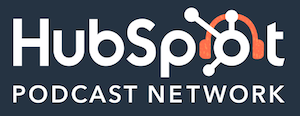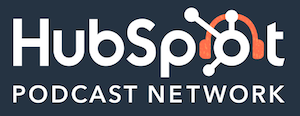A New Generation of AI: ChatGPT written by John Jantsch read more at Duct Tape Marketing
Marketing Podcast with John Jantsch
 In this episode of the Duct Tape Marketing Podcast, I’m doing a solo show, and I’m gonna talk about a trend that has gotten so high in the past few months, ChatGPT.
In this episode of the Duct Tape Marketing Podcast, I’m doing a solo show, and I’m gonna talk about a trend that has gotten so high in the past few months, ChatGPT.
Key Takeaway:
Nowadays, we look for tools that let us be more productive and help us save an immense amount of time. AI is a really hot trend now and accessible to make some of our tasks easier. The newest trend in AI is ChatGPT, a tool that will change how we work and become smarter in how we collect useful information and data for our businesses in order to create smarter strategies. In this episode, I teach you how ChatGPT will be shaking up the way we do things and gain knowledge.
Topics I Cover:
- [01:51] What is ChatGPT?
- [03:38] Why use this tool?
- [04:32] The process of using AI
- [06:49] How to use AI to create Hubpages for your business
- [08:43] Discover what your ideal customer needs or wants
- [11:51] How to use ChatGPT to create online content
Resources I mention:
- Send John an email
More About The Agency Certification Intensive Training:
- Learn more about the Agency Certification Intensive Training here
Take The Marketing Assessment:
- Marketingassessment.co
Like this show? Click on over and give us a review on iTunes, please!
John Jantsch (00:00): This episode of the Duct Tape Marketing Podcast is brought to you by Outbound Squad, hosted by Jason Bay, and brought to you by the HubSpot Podcast Network. The audio destination for business professionals host Jason Bay, dives in with leading sales experts and top performing reps to share actionable tips and strategies to help you land more meetings with your ideal clients. In a recent episode called Quick Hacks to Personalize Your Outreach, he speaks with Ethan Parker about how to personalize your outreach in a more repeatable way. Something every single one of us has to do it. Listen to Outbound Squad, wherever you get your podcasts.
(00:49): Hello and welcome to another episode of the Duct Tape Marketing Podcast. This is John Jantsch and I’m gonna do another solo show. If you listen to my last show, I started off by saying I wanna talk about a trend. I guess today I’m gonna talk about a really hot trend
(01:34): If you ever use Google Maps and it gets you to
(02:27): Data tools have gotten better. Let’s face it. There’s no question. I think that while there are some tools like Jasper and Write, Sonic Market Muse that have been around for a while, I think the real game changer came when OpenAI ChatGPT, I’m sure you’ve, if you’re not using it, I’m sure you’ve heard people talk about it because it has really opened up the white hot topic of ai and it’s, you know, when that type of thing happens, you get so much chatter out there that it’s really hard to kind of cut through. I remember, this is going way back, so hang on cuz I’m gonna do a grandpa thing, almost internet grandpa. Anyway, you know when Twitter came around finally, I don’t know what year it was, 2008, 2009, it is. It’s like, if you’re not on Twitter, you know, you’re just like not cool.
(03:19): And I think that’s kind of where we are with AI to some degree, but let me just tell you, it is an amazing tool, not because it, well, if you’re a student out there, maybe it’s writing your essays, but as marketers, you’re not u going to use this tool today to create all of your content. You’re gonna use this today as a tool to get smarter about your customers, to get smarter about the industry, to get smarter about your competition, to create plans, content, no question. And to do a lot of mundane tasks, to get ideas, to get research. So that’s the way that, that, I’m not saying that we won’t get there one day where you just push a button and it’s writing, you know, your webpages for you. But what it’s doing right now, think of it right now as a a, a time saving efficiency tool that’s gonna save you some brain cells
(04:20): You’re gonna go, oh yeah, five of those are good. I didn’t have to use any brain power
(05:07): First person
(06:02): So we wanna play to their strengths. So that’s gonna, we’re gonna definitely use that as a way to create a differentiator inside of tools like ChatGPT. All right, let me just spend the rest of our time together today giving you a list. I said 10, I’m, I’ll probably go more than that. I’m just going to throw out a list of the types of output that you should be getting out of ChatGPT or whatever tool you use. Again, shout out to Jasper is another great tool. Shout out to write Sonic, like the word write Sonic is a great tool, but you know, whatever tool you use, these are the types of things that, that you can do. It’s not just writing content. For example, something that we have specialized in the last decade or so is, you know, with our clients, we create something that are called HubPages.
(06:51): Blogs are totally out. Stop calling it a blog, stop putting blog in your, in your, uh, main navigation. Nobody cares. Nobody wants to read a blog. We want got good content, but we want it structured in a way we could find it. And frankly, the way most people see blogs is it’s kind of chronological content. You, you put in a blog post to today and you put in another one tomorrow and when you wrote yesterday is gone. And so what we do is we take all that great content and we structure it around the outline of a big hub topic. So again, for example, I use the remodeling contractor. If they remodel construction or uh, kitchens, you know, we might create the ultimate guide to remodeling your kitchen in whatever city
(07:37): In fact, you could type that exact prompt in to ChatGPT and it will give you a outline. Here are all the major chunks. It’s, you know, planning, it’s budgeting, it’s design, it’s construction, it’s, you know, it’s choosing appliances. I mean, basically all the kind of subcategories that go into a kitchen, major kitchen remodel, and it creates the outline for you. It even suggests steps all the way down to, yeah, that would actually be a good blog post. Why remodel Your kitchen probably would come up in that outline.
(08:30): Instead of just telling somebody, go read our blog and maybe you’ll find something I can, I, in fact, I’ve probably done shows on that topic. But if not just Google HubPages Duct Tape Marketing, you’ll get a very thorough description of what I’m talking about there. Another kind of fun use for this tool is wouldn’t it be great to know what your ideal customer lays awake in bed at night worrying about when it comes to making a purchase of whatever it is you sell
(09:24): So that sounds like a lot that can all go in one prompt. And then you are going to get a, a list of course of not just concerns, but actually sad in the way that a homeowner might say, you know, to deal with noise and budget and on time and you know all the things that you should be then addressing in your marketing. Hey, marketing agency owners, you know, I can teach you the keys to doubling your business in just 90 days or your money back. Sound interesting. All you have to do is license our three step process that’s gonna allow you to make your competitors irrelevant, charge a premium for your services and scale perhaps without adding overhead. And here’s the best part. You can license this entire system for your agency by simply participating in an upcoming agency certification intensive look, why create the wheel?
(10:23): Use a set of tools that took us over 20 years to create. And you can have ’em today, check it out at dtm.world/certification. That’s dtm.world/certification. So you can use these tools not just to produce content, but to actually produce strategy. In fact, another strategic use. Take all of your Google reviews, you can just copy ’em, paste them in there, and tell the tool to actually go through the above reviews that you just pasted in and create a sentiment analysis, which is just another way of saying what are some of the key themes,
(11:20): You could take those in a continuation, put those in and say, okay, create a core marketing message addressing these themes that keep coming up. And so all of a sudden now it’s gonna get creative with you. So think in terms of research for strategy to do things much, much faster. Maybe to give some insights that you don’t have today. You could take three of your competitors
(12:18): And you might actually get some decent content written that way. You can take that content that it writes and say, okay, now give me a two minute YouTube video script based on this content. Franka. You can do that with actually any content you’ve written. Let’s see, you have some amazing content on your website already that was professionally handwritten, bespoke, just for you. You could take it to these tools and say, give me 25 uh, tweets based on this content. Give me a two minute video script based on this content. Repurpose this content for a LinkedIn article. And you are gonna get all those things that you could probably create all on your own. In fact, you could do a great job creating those on your own, but you’ve now saved yourself, I don’t know,
(13:10): In fact, they just require somebody who understands how to do it. And these tools understand how I how to do it. Great example of that, writing metadata. So, you know, the titles and descriptions, you’ve probably heard every SEO person in the world talk about how important that is as an on page ranking factor. But it’s also, if you’ve got 10 blog posts, it’s also a bit mind numbing
(14:09): Google loves question and answers. FAQs have always been great content. There are certain types of people that they just want to go and find the one question they have and get it answered. So every single one of your service pages, if you offer different services or you offer different products or solutions, should, should have a list of FAQs, not just for the company in general. Yeah, maybe you have one of those that talks about how you work or about your process. But every one of your products and services should have cues. But you know, they take time, like everything they take brain power
(15:25): You can tell the, you know, I already mentioned the idea of social posts. It’s great at writing four specific Instagram, Facebook, Twitter. I mean, one of the things that’s sort of banding about social media is has a way to differentiate themselves. Each platform now has their own way they wanna see content and what kind of content and what style of content works and what shape the images are. And so using a tool like this to actually write for specific platforms, just take some of the work out of that. You can actually, let’s say you, you wanna make sure that you’ve got a marketing assistant that’s writing content for email newsletter every month for social posts, every month for blog posts every month. You can tell these tools, you can give it the key themes and say create a monthly editorial calendar. If you’re an agency, you can certainly do that for a client and it, and you may not execute on the thing for 12 months.
(16:16): But if you’re an agency or a coach or a consultant and you’re able to show in a proposal to a client, here’s what 12 months would look like, a typical sort of proposed 12 months editorial would look like. It’s a great sales tool. You know, again, like do you execute on every single thing that’s on there, you know, nine months from now, maybe not, but it actually is a great differentiator and is very efficient to produce. Speaking of efficiency, one of the things I’ve learned about advertising or ads, digital ads is you can sit around in a room and guess all you want and some people are probably better at it than others. Which ad, which headline, which picture, which uh, description, which call to action is actually going to be the best. But experience tells me that the only real data that you can rely on is data that you test.
(17:06): So testing your headlines, testing hundreds of variations for ads is how you really get to the winners. Obviously you’ve gotta track and you’ve gotta analyze and you’ve gotta have, you know, your audience variables, right? I mean, there’s lots of variables, but I do know that when it comes to creating lots of variations that you can test, these tools are super fast at doing that. And sometimes you just have to have a lot of volume in order to start testing. So let me ask you this. If you’ve listened to this far, ping me, just send me a note, john@ducttapemarketing.com. Say, I would love it if you would actually demo kind of a working session on, you know, a ChatGPT type of tool. Be happy to do that. So just write that, send me a note, leave me a review. We always love those.
(17:53): Tell other people to subscribe.
(18:21): Hey, and one final thing before you go. You know how I talk about marketing strategy, strategy before tactics? Well, sometimes it can be hard to understand where you stand in that, what needs to be done with regard to creating a marketing strategy. So we created a free tool for you. It’s called the Marketing Strategy Assessment. You can find it @marketingassessment.co, not.com, dot co. Check out our free marketing assessment and learn where you are with your strategy today. That’s just marketingassessment.co I’d love to chat with you about the results that you get.
Sign up to receive email updates
Enter your name and email address below and I’ll send you periodic updates about the podcast.
This Duct Tape Marketing Podcast episode is brought to you by the HubSpot Podcast Network.
 HubSpot Podcast Network is the audio destination for business professionals seeking the best education and inspiration to grow a business.
HubSpot Podcast Network is the audio destination for business professionals seeking the best education and inspiration to grow a business.
Did you miss our previous article…
https://www.sydneysocialmediaservices.com/?p=5391

 In this episode of the Duct Tape Marketing Podcast, I’m doing a solo show. Today, we have the ability now to start businesses without really adding much overhead. You don’t need an office – all you really need is a computer. But in order to scale, there are a few things you have to get right, and we’ve created a system to do just that.
In this episode of the Duct Tape Marketing Podcast, I’m doing a solo show. Today, we have the ability now to start businesses without really adding much overhead. You don’t need an office – all you really need is a computer. But in order to scale, there are a few things you have to get right, and we’ve created a system to do just that.
 In this episode of the Duct Tape Marketing Podcast, I’m doing a solo show on the 10 essential website elements every homepage needs to have.
In this episode of the Duct Tape Marketing Podcast, I’m doing a solo show on the 10 essential website elements every homepage needs to have.
